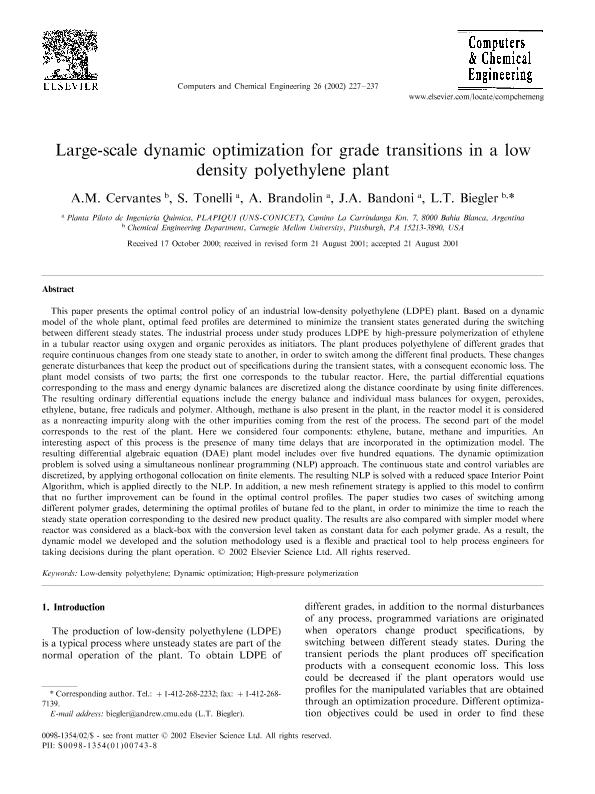Mostrar el registro sencillo del ítem
dc.contributor.author
Cervantes, A.M.
dc.contributor.author
Tonelli, S.
dc.contributor.author
Brandolin, Adriana

dc.contributor.author
Bandoni, Jose Alberto

dc.contributor.author
Biegler, L.
dc.date.available
2020-03-30T20:42:39Z
dc.date.issued
2002-02-15
dc.identifier.citation
Cervantes, A.M.; Tonelli, S.; Brandolin, Adriana; Bandoni, Jose Alberto; Biegler, L.; Large-scale dynamic optimization for grade transitions in a low density polyethylene plant; Pergamon-Elsevier Science Ltd; Computers and Chemical Engineering; 26; 2; 15-2-2002; 227-237
dc.identifier.issn
0098-1354
dc.identifier.uri
http://hdl.handle.net/11336/101426
dc.description.abstract
This paper presents the optimal control policy of an industrial low-density polyethylene (LDPE) plant. Based on a dynamic model of the whole plant, optimal feed profiles are determined to minimize the transient states generated during the switching between different steady states. The industrial process under study produces LDPE by high-pressure polymerization of ethylene in a tubular reactor using oxygen and organic peroxides as initiators. The plant produces polyethylene of different grades that require continuous changes from one steady state to another, in order to switch among the different final products. These changes generate disturbances that keep the product out of specifications during the transient states, with a consequent economic loss. The plant model consists of two parts; the first one corresponds to the tubular reactor. Here, the partial differential equations corresponding to the mass and energy dynamic balances are discretized along the distance coordinate by using finite differences. The resulting ordinary differential equations include the energy balance and individual mass balances for oxygen, peroxides, ethylene, butane, free radicals and polymer. Although, methane is also present in the plant, in the reactor model it is considered as a nonreacting impurity along with the other impurities coming from the rest of the process. The second part of the model corresponds to the rest of the plant. Here we considered four components: ethylene, butane, methane and impurities. An interesting aspect of this process is the presence of many time delays that are incorporated in the optimization model. The resulting differential algebraic equation (DAE) plant model includes over five hundred equations. The dynamic optimization problem is solved using a simultaneous nonlinear programming (NLP) approach. The continuous state and control variables are discretized, by applying orthogonal collocation on finite elements. The resulting NLP is solved with a reduced space Interior Point Algorithm, which is applied directly to the NLP. In addition, a new mesh refinement strategy is applied to this model to confirm that no further improvement can be found in the optimal control profiles. The paper studies two cases of switching among different polymer grades, determining the optimal profiles of butane fed to the plant, in order to minimize the time to reach the steady state operation corresponding to the desired new product quality. The results are also compared with simpler model where reactor was considered as a black-box with the conversion level taken as constant data for each polymer grade. As a result, the dynamic model we developed and the solution methodology used is a flexible and practical tool to help process engineers for taking decisions during the plant operation.
dc.format
application/pdf
dc.language.iso
eng
dc.publisher
Pergamon-Elsevier Science Ltd

dc.rights
info:eu-repo/semantics/openAccess
dc.rights.uri
https://creativecommons.org/licenses/by-nc-sa/2.5/ar/
dc.subject
Optimization
dc.subject
Polyethylene plant
dc.subject.classification
Ingeniería de Procesos Químicos

dc.subject.classification
Ingeniería Química

dc.subject.classification
INGENIERÍAS Y TECNOLOGÍAS

dc.title
Large-scale dynamic optimization for grade transitions in a low density polyethylene plant
dc.type
info:eu-repo/semantics/article
dc.type
info:ar-repo/semantics/artículo
dc.type
info:eu-repo/semantics/publishedVersion
dc.date.updated
2020-03-25T14:36:23Z
dc.journal.volume
26
dc.journal.number
2
dc.journal.pagination
227-237
dc.journal.pais
Países Bajos

dc.journal.ciudad
Amsterdam
dc.description.fil
Fil: Cervantes, A.M.. Carnegie Mellon University; Estados Unidos
dc.description.fil
Fil: Tonelli, S.. Consejo Nacional de Investigaciones Científicas y Técnicas. Centro Científico Tecnológico Conicet - Bahía Blanca. Planta Piloto de Ingeniería Química. Universidad Nacional del Sur. Planta Piloto de Ingeniería Química; Argentina
dc.description.fil
Fil: Brandolin, Adriana. Consejo Nacional de Investigaciones Científicas y Técnicas. Centro Científico Tecnológico Conicet - Bahía Blanca. Planta Piloto de Ingeniería Química. Universidad Nacional del Sur. Planta Piloto de Ingeniería Química; Argentina
dc.description.fil
Fil: Bandoni, Jose Alberto. Consejo Nacional de Investigaciones Científicas y Técnicas. Centro Científico Tecnológico Conicet - Bahía Blanca. Planta Piloto de Ingeniería Química. Universidad Nacional del Sur. Planta Piloto de Ingeniería Química; Argentina
dc.description.fil
Fil: Biegler, L.. Carnegie Mellon University; Estados Unidos
dc.journal.title
Computers and Chemical Engineering

dc.relation.alternativeid
info:eu-repo/semantics/altIdentifier/url/https://www.sciencedirect.com/science/article/abs/pii/S0098135401007438
dc.relation.alternativeid
info:eu-repo/semantics/altIdentifier/doi/http://dx.doi.org/10.1016/S0098-1354(01)00743-8
Archivos asociados
